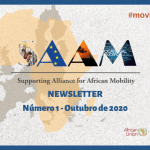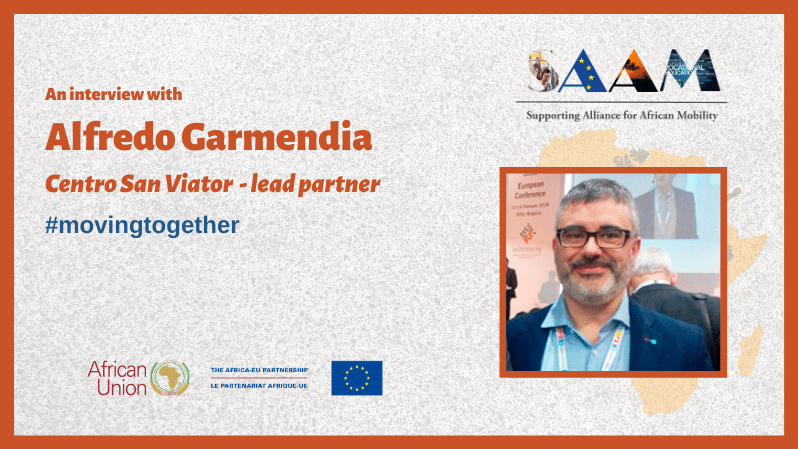SAAM is a two-headed project in terms of its leadership. Centro San Viator Sopuerta and Asociación Mundus have set up a strategic alliance in which two really relevant entities in the field of international mobility for learning purposes in Europe have joined forces for this pilot project.
As a referential vocational training center in Spain in the field of international mobility of VET students, San Viator has the crucial role of leading this project as applicant, in control of the overall evolution of SAAM from a strategic and financial point of view.
Alfredo Garmendia leads the international department of San Viator Sopuerta, a vocational training center in the north of Spain, in the Basque Country, very close to Bilbao. Alfredo is an old acquaintance in the European spaces for international mobility. In fact, he tells us, from these meetings arise the first links in establishing European partnership of SAAM. Hand in hand with Béatrice Bellet, strategic chief officer of Asociación Mundus, they are leading this exciting and challenging pilot project called SAAM.
Do you want to know more? Check out this Question and Answer interview with SAAM’s main carer!
As the applicant of the project, and the manager too, how long did it take to create and launch the project?
Well, the previous phase of the project was shorter than it should have been, as there were many things to do, but all of them at the same time. We had to write the application with Mundus, but at the same time launch a call with the aim of finding the relevant partners for the project, taking into account different criteria, like the experience in mobility projects. For that you have to talk to a lot of different organizations, explain them the project and see if they can be relevant actors for it.
Something difficult was that SAAM is a pilot, a project that had never been launched before, so we are facing a lack of information, because we are piloting something new. Hence most of the partners had a lot of questions and a lot of doubts; they were a little bit worried at the begging.
Another difficult task was to get the partners from Africa, but thanks to Don Bosco we were able to find relevant networks in Africa. We also had to keep in contact to find other partners than Don Bosco’s. We wanted to integrate VET providers, but also we wanted to bring as many countries and many organizations as possible, so that is why we asked EFVET and EVBB to be partners of the project. The partnership is composed not only by professionals from the VET sector, because we also looked for partners in the field of youth: in this case, we have YESforum, which is a relevant actor in the sector, and they are helping us quite a lot in developing modules that are not technical and not related to VET, but are more related to “how to cope” with the experience of a learning mobility from different points of view.
This project is really big and ambitious and will last at least 3 years. Is it the first time in your life that you are managing a project of this scope?
This is a pilot, so it has never happened before. Hence, this is a first experience for all of us. It is true that we looked for partners who already had experience in Africa: we have really experienced partners like the Finland or Portugal ones that have been working in Africa for many years. It is the same for the partners in Africa who have been working with Europe and other parts of the world. But SAAM is a pilot and it is the first experience for all of us in something similar. This is the very first time that my organization is involved in such a big project for sure. For us, it is a new challenge and kind of an adventure because we are discovering something new.
But San Viator has a great and long experience in terms of international projects. Since 2004, we are doing regular international mobility but we also have some really exceptional projects like mobility for people with intellectual disabilities since 2006. We had to face different barriers that other schools don’t have, as we have been moving people with special needs, but we go through it in the aim of giving the advantage to a lot of users and a lot of students, with opportunities to go abroad. We became an example of good practices in mobility of people with special needs, and this experience is a plus for managing SAAM as it is something new and challenging in mobility projects, too.
In San Viator, we know thanks to experiences and background how to deal with difficulties. In SAAM, that approach is always present from the very beginning, as it is a pilot with African countries, that for us are another culture and a different way of working. We can adapt our organization and help others to do the same.
San Viator has a great and long experience in terms of international projects
How has the COVID-19 crisis impacted your job?
Unfortunately, COVID is having a big impact in SAAM, which is a mobility pilot project. Since mobility is now impossible, we have had to adapt to new situations and scenarios; and we have indeed adapted to a new arena: we have prepared everything to be ready for mobility whenever it is possible. We had to cancel everything that was planned, like the Kick-off Meeting in Nairobi in April, so we did it online, with almost one hundred people, coping with all what was meant to be implemented in Nairobi… and what came afterwards! For example, we transformed part of the peer work into a 23 online meetings.
We are analyzing different possibilities for the next weeks and months, and we will see what we can and cannot realize. It is unfortunate that we should have already started with mobilities, but sooner or later we will do it! If mobilities are not possible through the last part of this year, we will get adapted and postpone them to January, or whenever it is possible.
But SAAM will never stop. If mobilities cannot take place in the next six months we will go on with the work that is possible to do now, we will go further with other parts of the project that should be developed a bit later.
Can you explain a day in your life as a member of SAAM?
Now it is a little bit calmer than before, because until mid-July every morning I opened my WhatsApp and there were, depending of the day, twenty or thirty messages related to different topics of SAAM. It could be related to the peer to peers that we had before summer, or validation, or the steering committee… There are a lot of different things going on, even though we are the only ones who know from behind. Then I have to go to my office for meetings: we always have a lot of meetings with partners or with our colleagues. This afternoon, for example, we have a meeting with the European Commission to chek in on SAAM.
So far, SAAM has been like a wave: you are in the sea and there is this wave that is coming once and again, once and again, and every time you think it is getting calmer, then here it is another wave! Cause we organized everything and then COVID appeared and we had to change a lot of things. So it seems that every day looks the same, because sometimes you think you are in the next step and suddenly something takes you back in the last step.
I love networking, I love the challenges and I love meeting new people, so for me SAAM has everything I like
What is your favorite aspect of being part of SAAM?
I love networking, I love the challenges and I love meeting new people, so for me SAAM has everything I like but not only in the professional sphere. I like that we are getting to know the reality of other countries in Africa. I mean, I have been to Tunisia and that’s it, it is my only experience in the African continent. So getting to know realities in different countries that are really different among them but also different with us… It is so interesting!
For example, at the peer to peers, listening to the exchange of experiences and contexts was amazing. Sometimes I get surprised because in this regard SAAM is flowing so much better that I had expected. More than that, SAAM is not only about teaching… The household has to integrate people who have grown in a war, in a conflict…
Do you have an advice for a well-managed project ?
Be water, my friend! You have to be flexible and empathetic, because sometimes the situation makes you mad, but the truth is that reality is in the middle of what I live and what you live, and that’s why you have to be patient and put yourself in other people’s shoes. Sometimes things appear to be crazy, but you also have to work in the shoes of the person in front of you to understand what they live and their point of view.
Also trust is really important. In SAAM, a keystone is that the partnership necessarily asks for confidence, which is something difficult to build but easy to break. That is why the work of communication, not only external but also internal is very important, because we need all the partners to be aware of the advances in SAAM! Internal communication is key to let everybody know where we are now at this point of the project. And this is not always easy, even more with the coronavirus and the distance between the different partners. In SAAM, we are 36 so it is very complex, because moreover every partner has his own reality, problems, challenges to deal with. That is why communication is a crucial aspect: in every partnership it is a way to go through and get to the final aim.
Can you describe SAAM in three words?
As I said in my speech for the Kickoff Meeting, for me SAAM sets bidirectional bridges.




